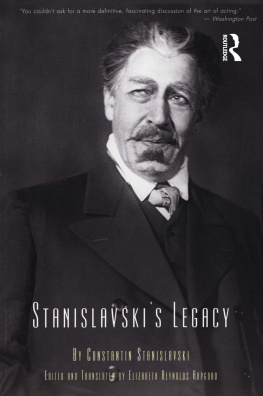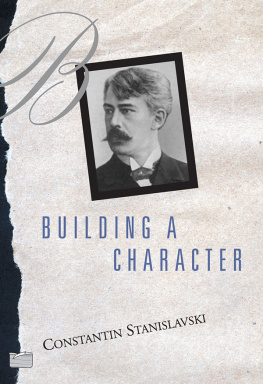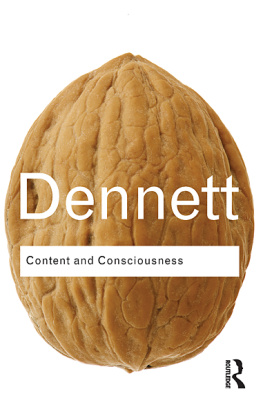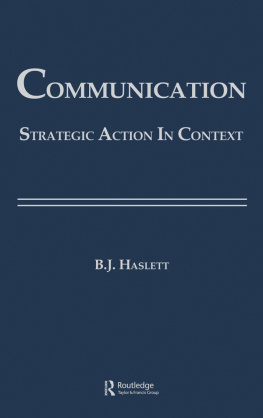Constantin Stanislavski - Stanislavskis Legacy
Here you can read online Constantin Stanislavski - Stanislavskis Legacy full text of the book (entire story) in english for free. Download pdf and epub, get meaning, cover and reviews about this ebook. year: 2015, publisher: Routledge, genre: Detective and thriller. Description of the work, (preface) as well as reviews are available. Best literature library LitArk.com created for fans of good reading and offers a wide selection of genres:
Romance novel
Science fiction
Adventure
Detective
Science
History
Home and family
Prose
Art
Politics
Computer
Non-fiction
Religion
Business
Children
Humor
Choose a favorite category and find really read worthwhile books. Enjoy immersion in the world of imagination, feel the emotions of the characters or learn something new for yourself, make an fascinating discovery.
- Book:Stanislavskis Legacy
- Author:
- Publisher:Routledge
- Genre:
- Year:2015
- Rating:4 / 5
- Favourites:Add to favourites
- Your mark:
- 80
- 1
- 2
- 3
- 4
- 5
Stanislavskis Legacy: summary, description and annotation
We offer to read an annotation, description, summary or preface (depends on what the author of the book "Stanislavskis Legacy" wrote himself). If you haven't found the necessary information about the book — write in the comments, we will try to find it.
Stanislavskis Legacy — read online for free the complete book (whole text) full work
Below is the text of the book, divided by pages. System saving the place of the last page read, allows you to conveniently read the book "Stanislavskis Legacy" online for free, without having to search again every time where you left off. Put a bookmark, and you can go to the page where you finished reading at any time.
Font size:
Interval:
Bookmark:

Art is a human activity having for its purpose the transmission to others of the highest and best feelings to which men have risen.
LEO TOLSTOY
Also by Constantin Stanislavski
An Actor Prepares
An Actors Handbook
Creating A Role
Building A Character
My Life in Art
Stanislavski on Opera
Stanislavski in Rehearsal
A Collection of Comments on a Variety of Aspects of an Actor's Art and Life
Constantin Stanislavski
Revised and Eapanded Edition Edited and Translated by Elizabeth Reynolds Hapgood

First published 1958
by Routledge
605 Third Avenue, New York, NY 10017
2 Park Square, Milton Park, Abingdon, Oxon OX14 4RN
Routledge is an imprint of the Taylor & Francis Group, an informa business
Copyright 1958 by Elizabeth Reynolds Hapgood
Copyright 1968 by Elizabeth Reynolds Hapgood
Why Play Melodrama was first published in Theatre Arts magazine, copyright 1950 by Theatre Arts, and is republished with its permission.
The Art of the Actor and the Art of the Director was written for the Encyclopedia Brittanica, where it appeared, in another translation and slightly different form, between 1929 and 1956. The text as it is published in this book is translated directly from the Russian version found in Stanislavskis papers.
All rights reserved. No part of this book may be reprinted or reproduced or utilized in any form or by any electronic, mechanical, or other means, now known or hereafter invented, including photocopying and recording, or in any information storage or retrieval system, without permission in writing from the publisher.
LIBRARY OF CONGRESS CATALOGING-IN-PUBLICATION DATA
Stanislavski, Constantin, 1863-1938
[Selections. English. 19991
Stanislavskis Legacy : a collection of comments on a variety of aspects of an actors art and life / by Constantin Stanislavski : edited and translated by Elizabeth Reynolds Hapgood.Rev. and expanded ed.
p. cm.
Originally published : New York : Theatre Arts Books, 1968.
ISBN 0-87830-127-5
1. Acting. I. Hapgood, Elizabeth Reynolds.
PN2062.S792213 1999
792.028dc21
98-52548
CIP
DOI: 10.4324/9781315059792
As time goes on more and more pieces written by Stanislavski, including letters, notes, comments of various kinds, come to light and being published add to the rich bequest already enjoyed by all who are interested in or capable of profiting by his lifes work. Thus this is not merely an afterglow which lingers briefly in a sunset sky.
Indeed, since Stanislavskis Legacy was first published in 1958, ostensibly to commemorate the twentieth anniversary of his death, the third volume of Stanislavskis main work came to light in three drafts, which were edited and put together with the help of Hermine Isaacs Popper as Creating a Role (1961). Later, from books already published in English and many other sources, I was able to glean his own pithy statements of his principal ideas and arrange them alphabetically to form a kind of dictionary of acting and the theatre. This we called An Actors Handbook (1963).
Now that an increasing demand for Stanislavskis Legacy has shown that it transcends its special occasion, Stanislavskis publishers have urged me to search through the residue of his writings that have since been made available to find statements that fill out what we published in 1958 and add new dimensions. With Mrs. Poppers help again, we have added to Part Three and created a new section which we have subtitled, from a phrase in a letter Stanislavski wrote to Max Reinhardt, Memories of the Past Dreams of the Future. Although some of these new materials date from his last active years all are an integral part of an overall pattern of Stanislavskis purposes and accomplishments in the theatre and in life.
Stanislavski stands apart from many great artists in the profession of acting because, together with his personal talentin itself very considerable and also a brilliant demonstration of his point of view of what acting could and should behe combined a rare quality of self-discipline. With his quick and deep sensitiveness he was as temperamentalin all its sensesas any actor ever is, yet by preserving his immense self-control all his forces were channeled into working with his fellow actors in their common enterprise of forwarding the ideas of the playwright, whom he often, with profound insight, called the poet.
Hence it was his life-long custom to delve into the subtext of any play, to find the essential meanings behind the printed words, really the inherent, when not always explicit, poetry of the authors inspiration, and then to translate that insight into the action of each character.
Thus his view when he was seventy is not essentially different from what it was when he was half that age, except that it was more far-reaching and more profound. He then had achieved a clearer realization that a life devoted to art is one of unremitting toil as well as one of high recompense in inner satisfactions.
Elizabeth Reynolds Hapgood
Petersham, Mass.
When Constantin Stanislavski died on August 8th, 1938 he was seventy-five and still in harness. I visited him in Moscow for two weeks in the Spring of 1937 and saw him work with actors from the Moscow Art Theatre on what later became a production of Tartuffe, I watched him rehearse young opera singers in Madame Butterfly, and I heard him discuss matters of art and theatre with a stream of visitors which included the ill-fated Vsevolod Meyer-hold and also Prokofieff. At the same time he was continuing to write whenever he had a free moment. This aspect of his work is the concern of the present volume, for it is the tragedy of the actor that when his final curtain is rung down the image he has created vanishes. All that remains is the imprint the image has made on the minds and hearts of his audience and that too is ephemeral. Photographs can suggest something of an actors power and versatility. The written word, if the actor happens to have the gift of verbal self-expression, provides a valuable and lasting record too, but the medium is so different from that of the acted word that often the impression gained by the reader is not altogether the one intended by the author.
Now twenty years after his death and thirty-five years after he appeared on the stage in America, Stanislavski is chiefly known as the author of two books which have been highly influential on the technique of acting in this countryAn Actor Prepares and Building A Character. Yet from reading about Stanislavskis method many misinterpretations arose. Some actors tended to choose what appealed to them the most and did not make the effort to become what ideally might be called the compleat actor in a part, just as some teachers who claim to expound Stanislavskis method actually use only a fraction of his all-embracing technique. Weird tales have been current of exaggerated feeling-your-part actors who went into something akin to a trance, of others who said they were grand pianos or something else equally unlikely and even a spool of purple thread in Danny Kayes amusing burlesque of Stanislavskiquite overlooking the fact that while training their imagination Stanislavski always dinned into his actors to say
Next pageFont size:
Interval:
Bookmark:
Similar books «Stanislavskis Legacy»
Look at similar books to Stanislavskis Legacy. We have selected literature similar in name and meaning in the hope of providing readers with more options to find new, interesting, not yet read works.
Discussion, reviews of the book Stanislavskis Legacy and just readers' own opinions. Leave your comments, write what you think about the work, its meaning or the main characters. Specify what exactly you liked and what you didn't like, and why you think so.






